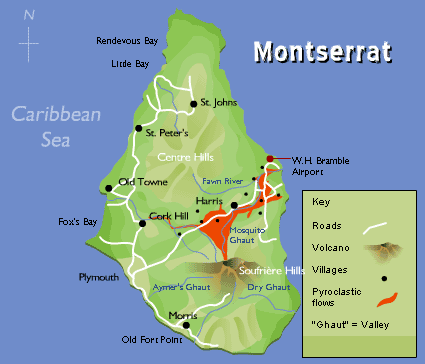Montserrat
THE ISLAND OF Montserrat, an overseas territory of the UNITED KINGDOM, is part of the chain of islands in the CARIBBEAN SEA that were formed millions of years ago by volcanoes, some of which remain active, while others are completely dormant. Montserrat itself is composed of seven active volcanoes of varying ages, which have been mostly inactive since the time of the island's colonization in the 1630s. But in July 1995, the Soufriere Hills began to emit hot ash and gases, forcing over two-thirds of the population from their homes and the abandonment of nearly half the island.
Like its neighbors to the north, ANTIGUA AND BARBUDA, and SAINT KITTS AND NEVIS, Montserrat was colonized by the British mostly for its potential for raising sugarcane. Its neighbor to the south is the French overseas department of GUADELOUPE. These islands also are volcanic in origin, and the Soufriere de Guadeloupe is an active volcano. Nevertheless, there had been little sign of imminent danger on Montserrat, and no emergency plans had been laid. Some evidence indicates that the island saw its last eruption about 18,000 to 19,000 years ago, but other evidence suggests it could have been as recent as the early 17th century, just before colonization. Indeed, the name of the most recently active area is the Soufriere Hills, named for the French term soufriere, a vent or fumarole that emits sulfurous gases and vapors (the French word itself is related to the English word sulfur).

CONTINUING ERUPTION
Certain recent seismographical readings indicated a rise in activity beneath the island, still the island was unprepared for the slow but steady eruption starting in July 1995, which has continued ever since. By August 1995, the capital, Plymouth, and all of the villages in the southwest and east were evacuated. Volcanic activity began with pyroclastic flows—mixtures of hot ash, boulders, and gases—followed by more serious explosions beginning in September 1996. In June 1998, the British government unveiled an aid package, but about half of the island will be uninhabitable for a decade.
Before the eruption, the island was relatively quiet. With a pleasant tropical climate and only a narrow coastal lowland, tourism was a mainstay, followed by production of rum, textiles, and electronic appliances. The future remains uncertain, with most of the population living in temporary quarters or off the island altogether. Scientists from around the world continue to monitor the situation at the new Montserrat Volcano Observatory, hoping to learn all they can from this occurrence to better protect against similar disasters in the future.